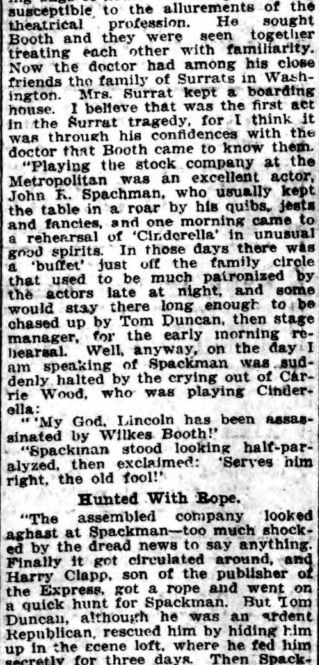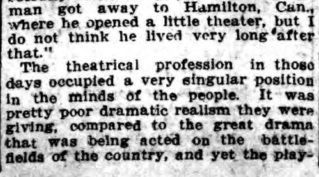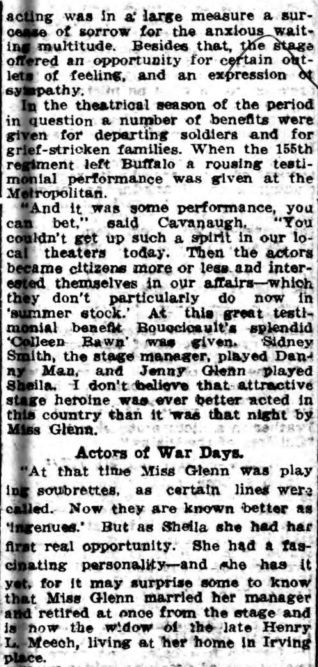Hi Jeff,
Quick question - Did David Herold work for Tumblety (1864) before he met Booth?
Mike
Props to H. B.
Collapse
X
-
Excellent stuff, Jeff. Thank you !
Ran into a bit of a brick wall trying to find another reference to Booth & Tumblety, aside from that newspaper article.
I'll keep at it.
Leave a comment:
-
Hi Howard,Originally posted by Howard Brown View PostI did a little searchin' and found that Booth's sister, Asia Booth Clarke, owned a home on 13th & Callowhill ( downtown Philadelphia ) in the late 1850's. IF Asia and her husband still lived there in 1863, its likely Booth stayed there and not at the Girard House, which stood at 9th & Chestnut, a fairly prestigious hotel in those days...actually a place you can imagine Booth wanting to stay at.
Tumblety stayed at the Girard House during 1863 before fleeing the city in late May.
If Booth was at that location and Tumblety was at Girard House...that's a 15 minute walk from Booth's sister's crib to Tumblety at the Girard House.
By the way, and I can't pin down the date....Booth got into a fistfight with a guy ( Figures, its Philly ! ), an actor named Roberts at the Girard House.
Back to the mines......
From what I recall, Asia was Wilkes' favorite sibling, so it is possible he did stay with her and her husband while in Philadelphia, but he also did enjoy the amenities and luxuries of being in that first or second generation of American stage celebrities living in the finest hostelries in the major cities.
One problem Wilkes had as the War continued was his morose anger at Yankee victory talk. In November 1864 Wilkes was in New York City, as he was to appear (for the only time in all their careers) with brothers Edwin and Junius Brutus Jr. on stage in a special benefit production of Shakespeare's "Julius Caesar" (ironically, given future history, Wilkes played "Marc Anthony", while his brothers were "Brutus/Edwin" and "Cassius/Junius"). The appearance of the three together (there is a famous photo still of them that is frequently reproduced) was on the night of that attack I mentioned by Confederate agents led by Col. Robert Martin and John Headley on the city, resulting in some damaging hotel fires and an attack on the piers and wharfs as well as Phineas Barnum's "American Museum".*
[*An interesting sidelight to the attack and the performance of the Booth Brothers was that as the fire alarms and fire engines roared throughout Manhattan that night (New York City was much smaller, concentrated really below 14th Street for the most part), the audience at the theatre panicked. While Edwin and Wilkes attempted to calm everyone from the stage, one of the audience people stood up and began to speak too and helped restore order our of the potential disaster. This was Mr. John McCunn, then a rising Police Court Judge, and his quick actions saved the people from injuring themselves. McCunn would eventually become a New York State Supreme Court Judge through his membership in Tammany Hall, but would be under a cloud due to his connection to Boss Tweed, and would be removed from the bench in 1873 (unfortunately he died shortly afterwards). It's interesting that McCunn acted so intelligently during the attack, as it is remarkably like his friend Tweed's similarly brave and intelligent behavior cooling down segments of the Draft Riot mobs a year earlier.]
Despite efforts by historians like Nat Brandt ["The Man Who Tried to Burn New York"]. Wilkes has never been found to be linked to this attack. But Wilkes stayed at Edwin's Gramercy Park home (the current "Player's Club"), and they had a major row the following day when Wilkes basically defended the attackers (it would have been like a New Yorker post "9/11" defending the "terrorists"). As a result Edwin, ever the loyal Union supporter, threw Wilkes out of his home.
I mention all this because Asia and her husband were like Edwin, in their pro-Union stand, and if the Draft Rioting of July 1863 incited Wilkes' southern patriotism he might have had a similar confrontation with his sister.
Jeff
Leave a comment:
-
I did a little searchin' and found that Booth's sister, Asia Booth Clarke, owned a home on 13th & Callowhill ( downtown Philadelphia ) in the late 1850's. IF Asia and her husband still lived there in 1863, its likely Booth stayed there and not at the Girard House, which stood at 9th & Chestnut, a fairly prestigious hotel in those days...actually a place you can imagine Booth wanting to stay at.
Tumblety stayed at the Girard House during 1863 before fleeing the city in late May.
If Booth was at that location and Tumblety was at Girard House...that's a 15 minute walk from Booth's sister's crib to Tumblety at the Girard House.
By the way, and I can't pin down the date....Booth got into a fistfight with a guy ( Figures, its Philly ! ), an actor named Roberts at the Girard House.
Back to the mines......
Leave a comment:
-
Damn straight about that Mike. Not only does it allow me to show my knowledge of theatre history, but it touches on my love of American Civil War era history and the soon to be 150th Anniversary of Lincoln's Assassination!Originally posted by mklhawley View PostOutstanding, Howard! The volume of angles to work from here is incredible. Jeff's probably the only one more excited than me.
Sincerely,
Mike
Jeff
Leave a comment:
-
Outstanding, Howard! The volume of angles to work from here is incredible. Jeff's probably the only one more excited than me.
Sincerely,
Mike
Leave a comment:
-
Hi Howard,Originally posted by Howard Brown View PostThanks Jeff...great material there !
When you brought up the Draft Riots, I thought that they might have been a factor in Tumblety steering clear of NYC and heading to the western part of New York State. However, those riots occurred on the 13th through the 16th, the middle of the month.
You might have missed the one scan I posted of the performance of the The Marble Heart..which Booth did perform in Philadelphia, but not Buffalo when he was there during July.
I seemed to recall a mention in an earlier posting of Booth in his only self-written part. I have never read "The Marble Heart", so I can only assume it is...err...typical of the claptrap that was popular dramaturgy in Britain, the U.S., and most of Europe in the 19th Century (possibly the most dismal century of recent ones in terms of creating living theatre - at least until Ibsen, Shaw, Pinero, Gilbert, Jones, Chekhov, Wilde, and Strindberg show up at the end of the century). The only successful one from earlier in the British Isles and America who still pops up is Dion Boucicault ("The Octoroon", "London Assurance", "The Colleen Bawn"), while a few of the French ones (Victorien Sardou, Victor Hugo, Alexandre Dumas Pere, and Alexandre Dumas Fils - the latter for "Camille"), and one Russian (Gogol - for "The Inspector Genera) hang in there.
A small volume of Wilkes Booth's surviving writings was published in the 1990s, and included the text of "The Marble Heart".
Maybe it was realizing what crap his repertory actually was made up of that turned Booth off from a stage career. Most likely though it wasn't.
Jeff
Leave a comment:
-
Thanks Jeff...great material there !
When you brought up the Draft Riots, I thought that they might have been a factor in Tumblety steering clear of NYC and heading to the western part of New York State. However, those riots occurred on the 13th through the 16th, the middle of the month.
You might have missed the one scan I posted of the performance of the The Marble Heart..which Booth did perform in Philadelphia, but not Buffalo when he was there during July.Last edited by Howard Brown; 04-12-2015, 04:17 AM.
Leave a comment:
-
Booth's Theatrical Parts
John Wilkes Booth did play Shakespearean parts. Here we see he played Richard III (the Duke of Gloucester at the start of that play, but sometimes it was spelled "Duke of Gloster" as that is how "Gloucester" is actually pronounced). Both "The Lady of Lyons" and "Money" were popular 19th Century plays by Edward Bulwer - Lytton ("The Last Days of Pompeii", "Eugene Aram", with it's well known awful opening, "It was a dark and stormy night" which has resulted in the modern day "Bulwer-Lytton" competition). "Money" is actually a comedy of manners that he wrote.
[His best recalled play (which Wilkes' brother Edward frequently performed) was "Cardinal Richelieu". If, by any chance, you should see the old biography film from 1936, "Cardinal Richelieu" with George Arliss in the title role (and supported by Edward Arnold as Louis XIII and Cesar Romero), it is based on the Bulwer-Lytton play, and note in particular Arliss's performing what was the high point of that role and play (which I'm sure Edwin Booth gave his all for - so did Arliss for that matter), "the curse of Rome" scene, where a threatened Richelieu warns his political enemies that as a Cardinal his death will bring upon them the damnation of the Papacy and of God. Heavy stuff in the 1850s. ]
The role Wilkes plays "Pescara" was in a play called "The Apostate" (Pescara is the title role).
Oddly enough Wilkes one contribution to the American stage and his own repertory is not here - the sculptor anti-hero in "The Marble Heart" which he co-wrote.
Jeff
Leave a comment:
-
General response to the article
Thanks for posting all this Howard. There are a few minor points I'd just add regarding the rioting and Booth's roles.Originally posted by Howard Brown View Post



In July 1863 New York City and several northern cities saw heavy rioting in the wake of the instituting of a national draft by the Federal Government. The New York City riots (now recalled as "the Draft Riots") led to attacking the offices where the Draft numbers were called, attacking Horace Greeley's Republican newspaper "the Tribune" (the "Herald - Tribune" would not exist until the 20th Century when the Tribune and James Gordon Bennett's newspaper "the Herald" joined together in a merger), attacking an Orphan Asylum and burning it (it was for African-American children), and hanging (lynching - and burning too) free African-Americans on the street that were unlucky to be captured, and also attacking and killing any pro-Union people who tried to confront the mobs alone. The exact number of dead has been variously given as low as one hundred and twenty and as high as one thousand three hundred. Hundeds of African-Americans fled out of Manhattan to New Jersey, Brooklyn (then a separate city), Long Island (read Queens), and even the northern part of New York City (the Bronx) to survive - it was decades before Manhattan Island had a sizeable African-American population again.
Manhattan had a history of riots - in 1849 there were riots against the British actor William Macready (whose great-grandson George would be a famous movie villain in films like "Gilda" and "Paths to Glory") by partisans of Edwin Forrest, then America's leading Shakespearean actor (or at least the chief rival to Junius Brutus Booth Sr. for that title). The "Astor Place Riots (Astor Place was where the theatre district was in 1849) ended when state mllitia fired on the rioters killing over 100. There had been a pitched battle in the 1850s on Broadway between street gangs over politics. Even after 1863 there was a serious riot, in 1871, between Irish Catholics and Irish Protestants on "Orange Day" which broke out over a parade.
During the 1863 riots Tammany leader (and future "Boss") William M. Tweed went around at great personal risk to convince the rioters to go home and stop inviting reprisals. It helped to cool things a bit (this aspect of Tweed's career was rarely noted due to his later notoriety, but recent studies of the man show he did believe in keeping the peace). His advise that July was sound - troops fresh from Gettysburg were sent to New York City and fired into the mobs.
I mention all this because it puts (somewhat) the nature of the 1863 Buffalo riots (which also center on anti-Black feelings) into perspective. It is also possible that Wilkes Booth's antics breaking that window were opened up by his own awareness of the rioting throughout New York State (and in the North in general) in the wake of the Draft legislation. Booth had been working for the South for awhile at this point helping to bring quantities of medical supplies to Southern locations, and in getting in touch with Confederate agents in Canada (where he possibly got to know fellow Confederate courier and agent John Surratt). Booth may have also been aware that Confederate agents in the North helped encourage those riots.
As for the breaking of the window, this was mild (really mild) in comparison to other antics by pro-Southern Northerners or Confederate agents in the later years of the Civil War and just after it. In November 1865 P.T. Barnum's famous Museum and Theatre on Anne Street in Manhattan burned down in a spectacular fire, the origins of which seemed based on arson Barnum was a well-known supporter of the Union, and in an earlier arson attack in the City (in November 1864 - when several hotels and wharfs were set on fire by Confederate agents) the American Museum had been attacked then too, but the fire was put out. It turned out that Barnum's Museum had a window display of wax figures showing the capture in May 1865 (at Danville, Georgia) of Jefferson Davis - and Davis's figure was covered by a woman's clothing outfit. A rumor (actually a lie) had circulated that the Confederate President tried to flee disguised as a woman, and the story was given credence in the North in the wake of Lincoln's murder. Actually Davis was accidentally given a woman's cloak instead of his own by Northern soldiers after his arrest when they led him away. But the wax figurines of the disguised Davis probably angered an ex-Confederate soldier or a sympathizer, who set the fire.
New York City was very pro-South in the Civil War. Much of the cotton trade to Europe was shipped through New York City. In fact, in 1861 Mayor Fernando Wood (later the Democrat's minority leader in the House of Representatives from 1867 to 1881) proposed the City either declare it's neutrality in the war or secede as a free city and port. Lincoln laughed at this proposal, saying that he never heard of the front porch seceding from the house. The large numbers of Draft rioters in New York City had come from Irish American immigrant groups (though not all the rioters) who resented the Draft: to them the Draft - which gave wealthier men a chance to purchase a replacement to fight for them in their place - was a rich man's party and a poor man's funeral.
Another Buffalo resident, a Democrat at the that time and later, was an up and coming lawyer who took advantage of the Draft law exception and paid for a substitute (who was badly wounded by military action). This lawyer would later be Sheriff and Mayor of Buffalo, then Governor of New York State, and then President of the United States twice (in non-consecutive terms, the only one to be that way). it was Stephen Grover Cleveland. And his use of the substitute was used against him in all his political campaigns by his opponents.
Jeff
Leave a comment:
-
My pleasure, GUT.
I think it is very likely that these two met in Philadelphia.
At least in one sense we're fortunate that there is no mistake about where Booth was in 1863 at the two critical times ( Feb.- March and July ). Tumblety was definitely in Philly in Feb.-March 1863....and Cavanaugh states he was there during the time Booth was in Buffalo in July in the 1914 newspaper article....but it would be nice to find something else which showed where Tumblety was during the time he left Philadelphia and say, before September of 1863, when we know he was in Albany.
Leave a comment:

Leave a comment: